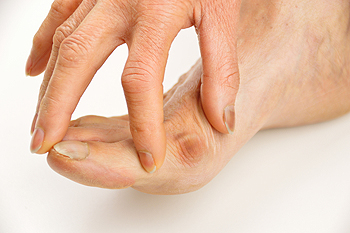
 A Tailor’s bunion is similar to a regular bunion. However, a Tailor’s bunion forms on the 5th metatarsophalangeal joint (or the “pinky toe”) as opposed to the big toe. A Tailor’s bunion can have a few different causes that include a biomechanical abnormality, heredity, or ill fitting shoes. A biomechanical abnormality can occur when there is too much motion in one part of the foot when stability is needed. Poor fitting shoes that have a limited and pointed toe box can cause a Tailor’s bunion to develop. Some common treatments include orthotics, padding over the painful area, and switching to shoes that are wider, but in severe cases, surgery may be necessary. If you think you might be experiencing a Tailor’s bunion, make sure to consult a podiatrist for a proper diagnosis and treatment.
A Tailor’s bunion is similar to a regular bunion. However, a Tailor’s bunion forms on the 5th metatarsophalangeal joint (or the “pinky toe”) as opposed to the big toe. A Tailor’s bunion can have a few different causes that include a biomechanical abnormality, heredity, or ill fitting shoes. A biomechanical abnormality can occur when there is too much motion in one part of the foot when stability is needed. Poor fitting shoes that have a limited and pointed toe box can cause a Tailor’s bunion to develop. Some common treatments include orthotics, padding over the painful area, and switching to shoes that are wider, but in severe cases, surgery may be necessary. If you think you might be experiencing a Tailor’s bunion, make sure to consult a podiatrist for a proper diagnosis and treatment.
If you are suffering from bunions, contact Dr. Thomas Tran of Southwestern Foot & Ankle Associates, P.C.. Our doctor can provide the care you need to keep you pain-free and on your feet.
What Is a Bunion?
A bunion is formed of swollen tissue or an enlargement of boney growth, usually located at the base joint of the toe that connects to the foot. The swelling occurs due to the bones in the big toe shifting inward, which impacts the other toes of the foot. This causes the area around the base of the big toe to become inflamed and painful.
Why Do Bunions Form?
Genetics – Susceptibility to bunions are often hereditary
Stress on the feet – Poorly fitted and uncomfortable footwear that places stress on feet, such as heels, can worsen existing bunions
How Are Bunions Diagnosed?
Doctors often perform two tests – blood tests and x-rays – when trying to diagnose bunions, especially in the early stages of development. Blood tests help determine if the foot pain is being caused by something else, such as arthritis, while x-rays provide a clear picture of your bone structure to your doctor.
How Are Bunions Treated?
If you have any questions, please feel free to contact our office located in Frisco, TX . We offer the newest diagnostic and treatment technologies for all your foot care needs.
Copyright © Southwestern Foot and Ankle Associates, P.C. | Site Map | Nondiscimination | Design by: Podiatry Content Connection